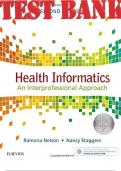,TEST BANK FOR
Health Informatics: An Interprofessional Approach 2nd Edition
by Ramona Nelson, Nancy Staggers
Table of Contents
Chapter 01: An Introduction to Health Informatics
Chapter 02: Theoretical Foundations of Health Informatics
Chapter 03: Evidence-Based Practice, Practice-Based Evidence, and
Informatics
Chapter 04: Models, Theories, and Research for Program Evaluation
Chapter 05: Technical Infrastructure to Support Healthcare
Chapter 06: Electronic Health Records and Applications for Managing
Patient Care
Chapter 07: Administrative Applications Supporting Healthcare Delivery
Chapter 08: Telehealth and Applications for Delivering Care at a Distance
Chapter 09: Home Health and Related Community-Based Systems
Chapter 10: Clinical Decision Support Systems in Healthcare
Chapter 11: Public Health Informatics
Chapter 12: The Evolving ePatient
Chapter 13: Social Media Tools for Practice and Education
Chapter 14: Personal Health Records (PHRs)
Chapter 15: mHealth–The Intersection of Mobile Technology and Health
Chapter 16: Identifying and Selecting an Information System Solution
Chapter 17: Project Management Principles and Clinical Systems
Chapter 18: Contract Negotiations and Software Licensing
Chapter 19: Implementing and Upgrading an Information System Solution
Chapter 20: Health Information Systems: Downtime and Disaster Recovery
Chapter 21: Improving the User Experience for Health Information Technology Products
Chapter 22: Informatics-Related Standards and Standards-Setting Organizations
Chapter 23: Data Science and Analytics in Healthcare
Chapter 24: Patient Safety and Quality Initiatives in Informatics
Chapter 25: Legal Issues, Federal Regulations, and Accreditation
Chapter 26: Privacy and Security
Chapter 27: The Health Information Technology for Education and Clinical Health (HITECH) Act,
Chapter 28: Health Policy and Health Informatics
Chapter 29: Health Information Technology Governance
Chapter 30: Informatics in the Curriculum for Healthcare Professionals
Chapter 31: Distance Education: Applications, Techniques, and Issues
Chapter 32: Informatics Tools for Educating Health Professionals
Chapter 33: Simulation in Healthcare Education
Chapter 34: International Informatics Efforts
Chapter 35: The Evolution of Health Informatics
Chapter 36: Future Directions and Future Research in Health Informatics
,Chapter 01: An Introduction to Health Informatics
Nelson and Staggers: Health Informatics: An Interprofessional Approach, 2nd Edition
MULTIPLE CHOICE
1. Dr. James, in studying patient safety in U.S. hospitals, found that the number of preventable
adverse events leading to serious harm fell in the approximate range of to
cases per year.
a. 4.4 million; 8.8 million
b. 440,000; 880,000
c. 1 million; 5 million
d. 40,000; 100,000
ANS: A
Dr. James found some 440,000 cases of lethal harm each year and estimated that the incidence of
serious (but not lethal) harm was 10 to 20 times that figure.
DIF: Cognitive Level: Analyze REF: p. 1
2. Health informatics is both a as well as a(n) .
a. discipline; field of study
b. profession; practice
c. field of study; art
d. profession; discipline
ANS: D
Health informatics is a discipline, or field of study, in the same sense that “medicine,”
“sociology,” and “pharmacy” are fields of study. It is also a profession, practiced by thousands of
informaticians in a number of varied roles within the healthcare industry.
DIF: Cognitive Level: Remember REF: p. 2
3. The top three uses of the U.S. Army’s telehealth network include all of the following EXCEPT
.
a. behavioral telehealth
b. cardiology
c. otolaryngology
d. dermatology
ANS: C
The biggest use of the U.S. Army’s telehealth network is for behavioral telehealth, followed by
cardiology and dermatology. While telemedicine is making inroads in otolaryngology, it is not
among the top three uses for the U.S. Army.
DIF: Cognitive Level: Remember REF: p. 3
4. What is the main idea of the subsection titled “Why Informatics Is Needed in Healthcare: An
Example”?
, a. An interoperable healthcare system that provides clear, concise patient data and
information among institutions is lacking in many facilities, and its presence would
greatly facilitate things such as patient transfers.
b. The quality of discharge communication during transfers of geriatric patients from
hospital to nursing home is generally high.
c. Skilled nursing facilities aren’t trained enough to identify the information they
need to facilitate a high-quality transition of a patient into their facility.
d. Healthcare informaticians alone are responsible for building interoperable systems
that will facilitate communication between and among healthcare facilities.
ANS: A
This subsection takes the specific case of the transfer of geriatric patients from a hospital setting
to a long-term skilled nursing facility (SNF) and uses it to illustrate the great need for an
interoperable healthcare system that allows patient data to be transferred quickly, clearly, and
concisely among facilities.
DIF: Cognitive Level: Analyze REF: p. 3
5. The chapter makes the argument for increased automation for such things as managing supplies,
because studies have shown that .
a. only 70% of a nurse’s day is actually spent at patients’ bedsides
b. nurses waste “an hour a shift” finding equipment
c. over $14 million in nurses’ wages nationwide were spent in 2011 on tasks like
hunting for equipment
d. patients report being comforted by the presence of robotic technology in their
rooms
ANS: B
The chapter focused on using health informatics and technology solutions to free up nurses’ days
so they can spend more time at patients’ bedsides and less on extraneous duties. A 2011 study by
the Robert Wood Johnson Foundation found that nurses do use an hour per shift of their time
simply hunting down equipment.
DIF: Cognitive Level: Understand REF: p. 3 | p. 4
6. The is one of the oldest—and still widely used—methods for building and
implementing software applications in IT arena.
a. TUG
b. clinical decision support system
c. HIPAA
d. SDLC
ANS: D
Though it’s been through a number of iterations and adjustments, the software development life
cycle remains the tested and tried-and-true method for studying, building, implementing, and
maintaining a health information system.
DIF: Cognitive Level: Remember REF: p. 4 | p. 5




